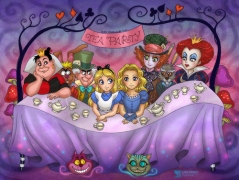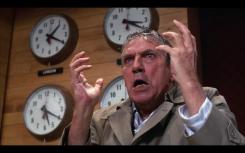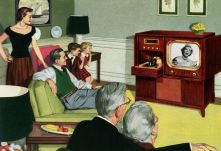Part Four
Every person you meet should be regarded as one of the walking wounded. We have never seen a man or woman not slightly deranged by either anxiety or grief. We have never seen a totally sane human being. – Robert Anton Wilson
Lesley Stahl on U.S. sanctions against Iraq (1996): We have heard that a half million children have died. I mean, that’s more children than died in Hiroshima. And, you know, is the price worth it? Secretary of State Madeleine Albright: I think this is a very hard choice, but the price, we think the price is worth it.
White children, in the main, and whether they are rich or poor, grow up with a grasp of reality so feeble that they can very accurately be described as deluded. – James Baldwin
I didn’t just screw Ho Chi Minh. I cut his pecker off. – Lyndon Johnson
The U.S. military coined the phrase “Shock and Awe” in the late 1990s and applied it to the invasion of Iraq a few years later. It accurately describes the American psyche. The “shock” side is composed of fear-mongering and electronic stimulation. This alone is more than enough to maintain our constant state of anxiety. But our optimistic character simultaneously pulls us in the opposite direction, and together they make us crazy in our uniquely American way.
The “awe” side, our third factor, is represented by our old tradition of advertisers, real estate salesmen, stock brokers, hucksters, con-men and “public relations” specialists, as well as clergymen and politicians, who collude to reinforce our denial. Characteristic themes include: the market is always rising, “doom-and-gloomers” overrate our problems; global warming is a lie; unemployment is down; racism is history; history itself is a feel-good story of constant progress; the Iraqis and Afghans (and soon, the Iranians, Syrians and Venezuelans) welcome us – all translatable into “the system is working.” An essential part of this message is visual images: idealized pictures of the America that Trump promises to make great (and white) again.  You know what I’m talking about: pristine coastlines, carefree drivers on uncrowded country roads, slim athletes and dancers, the family dinner, Sunday church picnics, reunions at Grandma’s house and small-town July Fourth celebrations.
You know what I’m talking about: pristine coastlines, carefree drivers on uncrowded country roads, slim athletes and dancers, the family dinner, Sunday church picnics, reunions at Grandma’s house and small-town July Fourth celebrations.
The speed and frivolity of the media charms us all and conveys our values primarily through two film and TV styles. In one – action and disaster films – the redemption hero intercedes to save the community from evil, traditionally in the last reel or just before the final commercial break. Since 1990, when Islam replaced communism as the external Other, a new generation has grown up watching literally dozens of movies and TV shows depicting this threat, but with a series of (usually white) American heroes eliminating the threat. Zero Dark Thirty and American Sniper are merely the more well-produced and honored of this genre.
Disaster films work both sides of the fear/denial dichotomy by heightening anxiety (and perhaps anticipation) of apocalyptic punishment and then cleanly resolving the threat through the intercession of selfless heroes. It’s a world of crimson red, dark brown and black, with very little grey area (or grey matter). Guy stuff.
The other mode is the ubiquitous, cloying, Disney-style  cartoons and children’s programming, in which, writes Todd Gitlin, “…characters are incarnations of an innocence that can never be dispelled,” where everyone talks out their problems, resolves them, hugs and remains friends. It’s a pastel world of pinks and lavender that still portrays most positive characters as white and heterosexual. Gal stuff.
cartoons and children’s programming, in which, writes Todd Gitlin, “…characters are incarnations of an innocence that can never be dispelled,” where everyone talks out their problems, resolves them, hugs and remains friends. It’s a pastel world of pinks and lavender that still portrays most positive characters as white and heterosexual. Gal stuff.
TV news (FOX News aside) offers a parallel experience. Reassuringly calm, unemotional, authoritative newscasters place even bad news in the wider context of progress: It’s all good. Michael Ventura, however, measures how deeply “…people know that ‘it’ is not all right…by how much money they are willing to pay to be ceaselessly told it is.” Think positive or don’t watch at all.
 Actually, even the calm Walter Cronkite father figures are mostly long gone. What we have had instead for many years are actors such as Matt Lauer who portray journalists or debate moderators, mixing in cornball humor and soft-core porn
Actually, even the calm Walter Cronkite father figures are mostly long gone. What we have had instead for many years are actors such as Matt Lauer who portray journalists or debate moderators, mixing in cornball humor and soft-core porn  so things don’t get too boring. With Fox news “commentators” such as these,
so things don’t get too boring. With Fox news “commentators” such as these,  no wonder the Trumpistas get their opinions there. Again, Fox is only the most extreme, as this list of the “25 Most Gorgeous News Anchors” attests. MSNBC balances it on the “left,” the two of them defining the narrowly acceptable range of political discourse for the diminishing numbers of Americans who consume news outside of social media.
no wonder the Trumpistas get their opinions there. Again, Fox is only the most extreme, as this list of the “25 Most Gorgeous News Anchors” attests. MSNBC balances it on the “left,” the two of them defining the narrowly acceptable range of political discourse for the diminishing numbers of Americans who consume news outside of social media.
Indeed, it has been clear since well before 9-11 that both politics (best seen in our embarrassingly silly Presidential debates) and news journalism have been so “dumbed-down” that we now perceive them as merely alternative forms of entertainment. This is laughable, as it was surely meant to be. But it also means that for many of us “reality” simply isn’t real any more, that it’s indistinguishable from anything else that appears on the screen – or that it’s all good.
Thus, in the midst of massive denial about a collapsing environment and the real economic and spiritual sources of terrorism, Americans fret about issues that the media choose to present. The most common source of our anxiety becomes either dark-skinned others or, in the case of mass killings, the disturbed individual, the bad seed, rather than systemic inequities and corruption. In this fantasy, immigrants and home-grown thugs, rather than discriminatory housing patterns and long-term unemployment, cause domestic violence. And Islamic fundamentalism, rather than American military intervention, causes most international violence.
Periodically, episodes of real terror evoke the old frontier paranoia (at the risk of being slimed as a conspiracy theorist, I insist that we have mountains of evidence that many of these events have been contrived).Then, as Ben Franklin lamented long ago, we quickly exchange our freedoms for a dubious sense of security.
The gated community has become yet another potent symbol.  Four centuries after defining themselves in contrast to the demonic forces of the wilderness, whites are once more circling the wagons. Forty percent of new California homes are in gated communities. Nationally, 8 million people live in them. Madness at the gates: as we enclose ourselves in racially homogeneous, suburban ghettoes or high-security high-rises, we simultaneously imprison more people than any nation in history and warehouse millions of others in nursing homes. Out of sight; out of mind.
Four centuries after defining themselves in contrast to the demonic forces of the wilderness, whites are once more circling the wagons. Forty percent of new California homes are in gated communities. Nationally, 8 million people live in them. Madness at the gates: as we enclose ourselves in racially homogeneous, suburban ghettoes or high-security high-rises, we simultaneously imprison more people than any nation in history and warehouse millions of others in nursing homes. Out of sight; out of mind.
Here we are, at the core of who we are: the condition of simultaneous denial and anxietyleads to paradoxical connections. For years polls have commonly reflected our belief that things were better in the old days, that things are going downhill – even if our personal outlook is rosy. But it’s more serious than that. Joy DeGruy’s 2005 book Post Traumatic Slave Syndrome: America’s Legacy of Enduring Injury and Healing described the multi-generational trauma experienced by African Americans. We can easily understand how the victims of over three centuries of violence and discrimination can pass their suffering on to their children. In the simplest of terms, racism causes PTSD, and it lives on its victims.
Traumatic events can happen to anyone, not just minorities. The government estimates that 10% of women and 4% of men will have PTSD at some point in their lives, about 8 million adults during a given year. That number is ridiculously low, given 36 million African-Americans, seven million Native Americans, 60 million Latino-Americans, several million LBGT people, the massive opioid epidemic and a thousand suicides per week, including 140 veterans and six active-duty service members. Given also, that one in four girls and one in six boys will be sexually abused before they turn 18 years old.
Given also, that over half of the population doesn’t have enough money to cover a $1,000 emergency. Given also, that, officially, 20% of children live in poverty, some 16 million. That number, again, is ridiculously low, since that the federal poverty threshold for a family of three (one adult + two kids under age 17) is about $22,000. So a family reporting one dollar more than that is not considered impoverished by the government. Rod Tweedy writes:
Capitalism is as much an inequality-generating system as it is a mental illness producing system. As a Royal College of Psychiatrists report noted: ‘Inequality is a major determinant of mental illness: the greater the level of inequality, the worse the health outcomes. Children from the poorest households have a three-fold greater risk of mental ill health than children from the richest households. Mental illness is consistently associated with deprivation, low income, unemployment, poor education, poorer physical health and increased health-risk behavior.
Those with steady employment hardly escape. Jeffrey Pfeffer, in Dying for a Paycheck, reports that 61 % of employees say that workplace stress had made them ill, with 7% requiring hospitalization. The stress of overwork, he writes, may cause 120,000 deaths annually in the United States.
Even those who see through the fear mongering and perceive neither immigrants nor “the Russians” as threats are subject to quite legitimate fear about the future. Sixty-two percent of us are “somewhat worried” about climate change and 23% are “very worried.” Counselors report seeing patients with anxiety, depression or a sense of helplessness. Although it is not an official clinical diagnosis (yet), terms for the phenomenon are already in use: “climate distress,” “climate grief,” “climate anxiety” or “eco-anxiety,” and Hollywood has responded with films and series such as The Dead Don’t Die, First Reformed, and Euphoria.
So we should acknowledge that trauma – caused by war, generational racism, underemployment, overwork, homophobia, poverty and realistic thinking, and expressed in suicide, mass violence, addiction and physical and mental illness – certainly affects many tens of millions of Americans. Dionysus might ask, who can separate legitimate stress from illegitimate stress? How long does a person or group suffer from stress before it becomes anxiety, before anxiety (real or not) becomes mental illness, or before they pass it on to their children?
But I am suggesting that the perpetrators of violence, as well as those (the majority) who have been indirectly privileged by that system have also been so dehumanized over those same centuries that most Americans have experienced some version of this epigenetic condition – transgenerational trauma – their entire lives. Psychologist Bryant Welch comments on the implications:
80% of the American public has experienced some form of significant traumatic experience, which we can reasonably anticipate will disrupt our effective psychological functioning…All the things that once supported the mind’s ability to construct its reality have been under assault, and the price we’re paying is terrible. People are becoming…so shaky in their trust in their own reality that when we see someone with a different reality, it’s too threatening to us and so we hate them…We all think of paranoia as irrational suspicion…but it’s a lot more. Paranoia takes place right at the boundary between what’s inside our mind and what is outside our mind, and that’s a pretty thin membrane and we can easily get confused on it.
Crazy or content, perpetrators, victims or detached observers, and despite our myths of equal opportunity, we all share the capitalist nightmare: one of the most unequal societies in history. And studies clearly show that, compared to more equal ones like Japan, we all suffer for it, writes Robert R. Raymond:
…in more unequal American states or European countries…only 15 or 20 percent of the population feel they can trust others. But in the more equal ones, it rises to 60 or 65 percent…The relationship between inequality and depression has been well documented… people in less equal states experienced higher rates of depression…
If we add the legacy of racism to the mix:
…we see higher rates of physical illness and chronic diseases like hypertension in Black Americans…Black adults are up to two times more likely to develop high blood pressure by age 55 than white adults.
Perhaps much of this is speculation; but tell me, reader, can you honestly say that modern life – and well before Trump – has not traumatized you?  Or if I could pose the question as Dionysus himself, or news anchor Howard Beale in the 1975 film Network: Why aren’t we all running through the streets screaming, “I’m mad as hell, and I’m not going to take it anymore!”?
Or if I could pose the question as Dionysus himself, or news anchor Howard Beale in the 1975 film Network: Why aren’t we all running through the streets screaming, “I’m mad as hell, and I’m not going to take it anymore!”?
Mythologically speaking, the gods are returning from exile. In historical terms, many Americans experience the traumas of racism, poverty, childhood abuse, misogyny or delayed stress. But we all suffer from the long-term, collective emotional effects of massive and rapid historical shifts: from paganism to monotheism, from rural to urban lives, from religious conformism and predictability to secular consumerism and nationalism.
We all suffer from dissociation, from the belief that we are separate beings, that maturity entails escaping the demands of the community, that we can and should detach our consciousness and our feelings from the terrible crimes of our government and the homeless misery that surround us. What does it mean to be reminded that babies are being torn from their parents or that all the large fish in the Pacific are contaminated from Fukushima – and then simply change the channel? How do our bodies interpret such bizarre behavior?
We all came into the world with another expectation, to exist within a container that provides us with divine figures – the gods and goddesses of mythology – who will convey images of our human potential. This is why, over thousands of years, most human societies evolved the mythology (granted, under patriarchy) of Kingship, and why, even now, in a democratic myth, we remain fascinated with its toxic mimic, the British Royal Family. We need images of nobility (related etymologically to knowledge) as well as human elders.
So what does it do to our indigenous souls to live our entire lives listening to celebrities and elected leaders – many of whom really are psychopaths – who lie to us continually, and, despite our rationalizations, to know very well at some level that they are lying? Or for the 35% of us who know but don’t care? What kind of insult to our archetypal expectations of being presented with the best of who we might be is this? Or to be told that our own perceptions are wrong (see below)?
Again, Trump is only the latest and grossest of examples. Noam Chomsky has long pointed out, without hyperbole, that “…if the Nuremberg laws were applied, then every post-war American president would have been hanged.” Can anyone deny that our political process has been so degraded, for so many decades, that no one could possibly be vetted to the level of serious presidential consideration who is not already crazed by the drive for power? One study proposes that “Nearly half of American presidents from 1789 to 1974 — and this includes two of the four U.S. leaders featured on the iconic Mount Rushmore — met the criteria for a psychiatric disorder.”
We recall that apocalypse means “to lift the veil.” Facing the truth is a grand opportunity to be dis-illusioned. To begin to extricate ourselves from this sticky, mythic mess, we have to acknowledge that this culture of death really does raise the very worst of us, those who embody the most extreme expressions of toxic masculinity, to the highest levels of praise and influence. When we hear of Trump’s latest outrage – or if we were to objectively consider the policies of his recent predecessors – any of them – we need to get past both the dark humor and the denials and accept that they are us. And for ourselves as Americans, the veil to be lifted – the clearer view of reality – is always, always about our perpetual attempts to remain innocent.
Part Five
A trait no other nation seems to possess in quite the same degree that we do—namely, a feeling of almost childish injury and resentment unless the world as a whole recognizes how innocent we are of anything but the most generous and harmless intentions. – Eleanor Roosevelt
…that omnipresent American narcotic, optimism, the unending flow of which poured through the American mind continuously, whitewashing the graffiti of despair, rage, hatred, and nihilism scrawled there nightly by the black hoodlums of the unconscious. – Viet Than Nguyen, “The Sympathizer”
The first act of violence that patriarchy demands of males is not violence toward women. Instead patriarchy demands of all males that they engage in acts of psychic self-mutilation, that they kill off the emotional parts of themselves. If an individual is not successful in emotionally crippling himself, he can count on patriarchal men to enact rituals of power that will assault his self-esteem. – bell hooks
So, Dionysus insists on asking, who defines sanity? And who profits from these definitions? For decades, Benjamin Rush’s definition prevailed: “…an aptitude to judge of things like other men, and regular habits, etc.” Freud added the abilities to love and work.
Thomas Szasz, however, insisted that most mental illness is composed only of behaviors that psychiatrists (overwhelmingly white, middle-class men) disapprove of. In his libertarian view, the “therapeutic state” uses psychiatric justifications to strip individuals of their rights. It creates two classes: those who are stigmatized as mentally ill and subject to coercive intervention, and the majority, whose conventional behavior indicates their innocence. “Only in psychiatry are there ‘patients’ who don’t want to be patients,” he says. No one else, neither priest nor judge, has the psychiatrist’s power to have someone committed, even if he came of his own free will. “If you’re in a building that you can’t get out of, that’s not a hospital; it’s a prison.”
Behaviors such as masturbation and homosexuality no longer fit, but others are continually added. But when psychotherapy (not to mention advertising) merely attempts to recover or maintain a sense of “productive normalcy,” that condition which is itself one of the causes of our unhappiness, it becomes yet another effort to recover lost innocence, as well as a condemnation of an archetypal experience ruled by Dionysus. Banishing him, we welcome ourselves to the madhouse, even if we don’t notice where we are.
So we are forced to confront yet another paradox: on the one hand, ours is an utterly mad culture, and vast numbers of Americans suffer from a deep sickness of the soul. On the other hand, a profoundly corrupt and extremely profitable, mostly private pharmaceutical-mental health-prison-industrial complex serves our elite classes by diagnosing millions as biologically and chemically imperfect, drugging them, institutionalizing them and identifying them as scapegoats for us all to pity and then forget about — until the next mass shooting. Indeed, as Ethan Watters writes, this medical model is spreading to most other nations.
We are the net products of a process that has taken some two hundred generations to unfold, reaching its peak with our current political and corporate leaders, most of whom are sociopaths or outright psychopaths, men who are driven to enact the shadow aspects of our national mythology for the rest of us.
Every American — at least every white American — suffers from suppressed grief, which returns as anxiety, addiction, narcissism and depression. The mad culture, led by madmen, regularly requires scapegoats whom we sacrifice to restore our innocence. Three million Viet Nam War veterans carry the burden of delayed stress for us all. Movies that portray them as ticking time bombs allow Middle America to consider memory’s immense power without confronting its universal application. But, says Dionysus, we are all ticking…They and all depressed people carry the shadow of our manic celebration of progress, extraversion, cheerfulness and grandiosity.
The more politicians and celebrities emphasize these American characteristics, the more depression will spread. We who can channel the madness into consumerism feel welcomed into the community of the elect, while those who cannot do so prove our righteous standing – and our innocence.
We’ve never been innocent, or “normal.” Three thousand years ago, the Greeks conjured up the figure of Dionysus to express their understanding that a large region of the psyche and of the world is so irrational, so driven by dark emotions that, by nature, it threatens to destroy the walls of the ego, all the more so because it is generally so repressed by the spirits of consciousness. They knew very well the costs of not honoring this god. They knew, as the classicist Walter Otto wrote, “A mad god exists only if there is a mad world which reveals itself through him.”
From this perspective, a major function of the myth of innocence is to suppress our grief and allow us to continue on as normal neurotics and normal consumers. Many men are well aware of this condition. Over my thirty years of participating in and leading mythopoetic men’s retreats, one of the most common statements I’ve heard is: I haven’t cried in thirty years, and I won’t allow myself to start. If I did, I know that it would never stop.
This is the indigenous soul leaking out, speaking in a language that normal ego consciousness cannot perceive, acknowledging that the sacred work of going down into grief requires a strong container of ritual and community and cannot be done alone. It acknowledges that part of the grief just below the surface of heroic, American male identity is the awareness that those containers have not existed for a very long time. The inability to grieve – or the perceived lack of permission to grieve – makes us crazy.
This is the baseline of stress and anxiety that most Americans endured right after the massive pains of World War Two and before that, the Depression. Since then, new factors have appeared.  The awkward combination of fear, denial and electronic stimulation has ruled our consciousness during the 70 years of television, which was born amid both McCarthyism and the new consumerism. Lucille Ball diverted us while Richard Nixon admitted, “People react to fear, not love.” I have argued, however, that the roots of this madness go back to the original confrontation of Puritans and Indians. Ever since, we have held the contradictory notions of chosen people and eternal vigilance.
The awkward combination of fear, denial and electronic stimulation has ruled our consciousness during the 70 years of television, which was born amid both McCarthyism and the new consumerism. Lucille Ball diverted us while Richard Nixon admitted, “People react to fear, not love.” I have argued, however, that the roots of this madness go back to the original confrontation of Puritans and Indians. Ever since, we have held the contradictory notions of chosen people and eternal vigilance.
In America, curiously, the plural phrase “chosen people” also evokes the radical individualist, the lone hero who chooses his own destiny and then goes out and achieves it. And he embodies one of our most fundamental values: social mobility, or the opportunity to get ahead. The likelihood of advancing in social class has decreased significantly since the 1980s. But 56% of those blue-collar men who correctly perceived G.W. Bush’s 2003 tax cuts as favoring the rich still supported them, apparently assuming (against all evidence) that they would someday be admitted to that exalted realm. Decades before, John Steinbeck wrote: “I guess the trouble was that we didn’t have any self-admitted proletarians. Everyone was a temporarily embarrassed capitalist.”
One story we tell ourselves about ourselves is that purpose can be divorced from community. The desire to be seen as special contributes to the quest for expensive symbols – a quest that is ultimately futile, wrote Phillip Slater, “…since it is individualism itself that produces uniformity.” Paradoxically, our American obsession with individualism produces persons who “cannot recognize the nature of their distress.”  This results in a desire to relinquish responsibility for control and decision-making to the images provided by the media. Here lies a great paradox of American life: our emphasis on the needs of the individual has contributed toward cultural and political conformism.
This results in a desire to relinquish responsibility for control and decision-making to the images provided by the media. Here lies a great paradox of American life: our emphasis on the needs of the individual has contributed toward cultural and political conformism.
But conformism and rebellious individualism are not our only choices. For tribal people, true community exists in order to identify and nurture the individuality of every one of its members, who are, in turn, necessary for the community to thrive and reimagine its values. Malidoma Somé writes that in West Africa, “Individuality is synonymous with uniqueness. This means that a person and his or her unique gifts are irreplaceable… A healthy community not only supports diversity, it requires diversity.”
The myth of individualism, of the self-made man is as deeply engrained as our wild, naïve optimism; in 2000, 19% believed they would “soon” be in the top one percent income bracket, and another 19% thought they already were. Two-thirds of us expect to have to pay the estate tax one day (only two percent will). Here is where the older myth intersects with New Age thinking, which preaches that right thinking will produce desired results. However, as I wrote above, most of us still accept the religiously-based corollary of those statements, that poverty is our own fault.
We expect, unlike any people in history, to successfully pursue happiness. Despite the secular terminology, it’s an essentially Protestant perspective, rooted in apocalyptic, end-times thinking. Yet our expectations of worldly happiness continually break up against that same Puritan heritage. Yes, we learned from Jerry Falwell, we should equate poverty with low moral status, and wealth does indicate our status among the elect. It does, doesn’t it? Please tell me it’s true. As I write in Chapter Seven,
Americans, like no people before them, strive for self-improvement. But within the word “improve” lies the anxiety of those who can never know if they’ve attained the otherworldly goal. Thus we must continually “prove” our status in this one.
Our characteristic American expectation of positive emotions and life-experiences makes feelings of sadness and despair more pathological in this culture than elsewhere. Christina Kotchemidova writes, “Since ‘cheerfulness’ and ‘depression’ are bound by opposition, the more one is normalized, the more negative the other will appear.”
When, in the great majority of cases, one realizes that his sacred assumptions of social mobility are unrealistic, the hero may encounter his shadow opposite – the victim – within himself, and we become what we really are (except for the thirteen years of Nazi Germany), the most violent people in history.
American crime is a natural by-product of our values, an alternative means of social mobility in a society where “anything goes” in the pursuit of success. “America,” says mythologist Glen Slater, “has little imagination for loss and failure. It only knows how to move forward.” When we can only imagine relentless progress and that movement is blocked — and communal grief is not an option — we may see no alternative but to go ballistic. Then guns become the purest expression of controlling one’s fate. As such, they are “the dark epitome of the self-made way of life.”
We as a people may well dream bigger dreams than other peoples. With great possibilities, however, come great risks. Gaps between aspiration and reality – the lost dream – are also far higher here than anywhere else. Cultural historian Greil Marcus writes,
To be an American is to feel the promise as a birthright, and to feel alone and haunted when the promise fails. No failure in America, whether of love or money, is ever simple; it is always a kind of betrayal.
When we don’t meet our expectations of success, when that gap gets too wide, violence often becomes the only option, the expression of a fantasy of ultimate individualism and control. In this sense, the Mafia is more American then Sicilian, and the lone, mass killer (almost all of whom have been white, middle class men with no criminal background) is an expression, writes Slater, of social mobility gone bad.
Myths are composed of unquestioned narratives, stories that we so consistently assume to be true that it never occurs to us to question them. But when we take an outsider’s perspective, we may quickly realize that one of these assumptions, the myth of the free market, is a prescription for craziness. Tweedy reminds us,
The corporation’s legally defined mandate is to pursue, relentlessly and without exception, its own self-interest, regardless of the…consequences it might cause to others. By its own legal definition, therefore, the corporation is ‘a pathological institution’…Capitalism is, it seems, rooted in a fundamentally flawed, naïve…model of who we are – it tries to make us think that we’re isolated, autonomous, disengaged, competitive, decontextualized – an ultimately rather ruthless and dissociated entity. The harm that this view of the self has done to us, and our children, is incalculable.
This notion of “ruthless and dissociated” is so much an unquestioned aspect of the story we tell ourselves about ourselves that it slides very easily into the common view of Trump and his supporters: gratuitous cruelty, or cruelty perpetrated simply because one has been encouraged to do so without any consequences. To me, this explains both the government’s astonishingly brutal immigration policies and the increase in mass shootings since his election. And, I must add, the degree to which we are still shocked by these policies is a measure of our own innocence, because Trump is us.
It may also explain why the opioid epidemic has hit Trump country most strongly. It turns out that taking antidepressants impairs empathy, while the experience of actual depression itself does not.
For two hundred years this American cycle of expectation and disillusionment has been playing out within the capitalistic narrative. Pankaj Mishra writes:
The ideals of modern democracy – the equality of social conditions and individual empowerment – have never been more popular. But they have become more and more difficult, if not impossible, to actually realize in the grotesquely unequal societies created by our brand of globalized capitalism.
As the myth of innocence collapses, more and more of us can perceive gashes in its fabric. Now there is a nearly universal consensus (obvious to all but the politicians and media hacks) that the capitalist perspective has corrupted every institution in society. We see this most especially in the pharmaceutical industry, with its gigantic lobbying budget. This has resulted (Cui bono?) in the medicalization of psychiatry and the over-diagnosing of mental disorders. I don’t want to veer too far off topic here, so I’ll just list some interesting links:
Are Psychiatrists Inventing Mental Illnesses to Feed Americans More Pills?
Majority of Youth Prescribed Antipsychotics Have No Psychiatric Diagnosis
Drug Companies & Doctors: A Story of Corruption
Manufacturing Depression: The Secret History of a Modern Disease
30 years after Prozac arrived, we still buy the lie that chemical imbalances cause depression
There Is No Definition of a Mental Disorder
How Big Pharma got Americans hooked on anti-psychotic drugs
Are America’s High Rates of Mental Illness Actually Based on Sham Science?
Renowned Harvard Psychologist Says ADHD is Largely a Fraud
How Drug Companies Helped Shape A Shifting, Biological View Of Mental Illness
Why Psychiatry Holds Enormous Power in Society Despite Losing Scientific Credibility
The History and Tyranny of the DSM
Are Prozac and Other Psychiatric Drugs Causing the Astonishing Rise of Mental Illness in America?
Psychiatry Now Admits It’s Been Wrong in Big Ways – But Can It Change?
And in pathologizing much natural human behavior, it has given a “scientific” reinforcement to our characteristic American refusal to grieve. I argue throughout my book, especially in Chapter Twelve, that our inability to confront our national shadows of genocide and slavery and our willing toleration of a brutal foreign policy are fundamentals aspect of American innocence. Few people can recover from trauma in an atmosphere that labels an appropriately lengthy mourning process as “major depressive disorder,” as Peter Kinderman writes:
Standard psychiatric diagnoses are notoriously invalid – they do not correspond to meaningful clusters of symptoms in the real world…Diagnoses fail to predict the effectiveness of particular treatments and they do not map neatly onto biological processes…it also sets the scene for the misuse and overuse of medical interventions such as anti-psychotic and anti-depressant drugs…diagnosis and the language of biological illness obscure the causal role of factors such as abuse, poverty and social deprivation. The result is often further stigma, discrimination and social exclusion.
So, the statistics that appear throughout this essay may well be inflated. Or maybe not.
Part Six
As long as we are at home in the body, we are absent from the Lord. – Increase Mather
Don’t blame Wall Street; don’t blame the big banks. If you don’t have a job, and you’re not rich, blame yourself. – Herman Caine
In a mad world, only the mad are sane. – Akira Kurosawa
God against man. Man against God. Man against nature. Nature against man. Nature against God. God against nature. Very funny religion! – D.T. Suzuki
So, the statistics that appear throughout this essay may well be inflated. Or maybe not. Robert Whitaker argues that the adverse effects of psychiatric medications are the primary cause of the epidemic. He reports that these drugs can cause moderate emotional and behavioral problems to become severe, chronic and disabling ones:
Once psychiatrists started putting ‘hyperactive’ children on Ritalin, they started to see prepubertal children with manic symptoms. Same thing happened when psychiatrists started prescribing antidepressants to children and teenagers. A significant percentage had manic or hypomanic reactions to the antidepressants.
These children and teenagers are then put on heavier duty drugs, including drug cocktails, and often do not respond favorably to treatment and deteriorate.  And that, for Whitaker, is a major reason for the 35-fold increase between 1987 and 2007 of children classified as being disabled by mental disorders. He acknowledges that the psychiatric community is coming around to sharing his opinions, especially on the pseudo-science behind the “chemical imbalance” theories of mental illness. However,
And that, for Whitaker, is a major reason for the 35-fold increase between 1987 and 2007 of children classified as being disabled by mental disorders. He acknowledges that the psychiatric community is coming around to sharing his opinions, especially on the pseudo-science behind the “chemical imbalance” theories of mental illness. However,
Psychiatry, all along, knew that the evidence wasn’t really there to support the chemical imbalance notion…and yet psychiatry failed to inform the public of that crucial fact…Researchers haven’t identified a characteristic pathology for the major mental disorders; no specific genes for the disorders have been found; and there isn’t evidence that neatly separates one disorder from the next. The “disease model,” as a basis for making psychiatric diagnoses, has failed…the entire edifice that modern psychiatry is built upon is flawed, and unsupported by science…Even as the intellectual foundation for our drug-based paradigm of care is collapsing, starting with the diagnostics, our society’s use of these medications is increasing; the percentage of children and youth being medicated is increasing; and states are expanding their authority to forcibly treat people in outpatient settings with antipsychotics drugs…I think we have to appreciate this fact: any medical specialty has guild interests, meaning that it needs to protect the market value of its treatments…Diagnosis and the prescribing of drugs constitute the main function of psychiatrists today in our society.
Cui Bono? So clearly, the industry survives and replicates itself in each generation by over-diagnosing countless people, especially children, many of whom exhibit only slightly more extreme behavior than normal people, and then pushing drugs on them. It follows, then, that the statistics at the top of this essay are probably inflated, and that there aren’t as many mentally ill among us as they would indicate. Wrong.
Because very large numbers of those suffering from legitimate mental conditions never appear in the surveys. How can you diagnose a homeless person who won’t enter a shelter; or a “functioning, productive alcoholic”; or a sexual predator priest; or a Big Pharma executive who jacks up the prices of critical drugs; or an openly racist member of Congress? Between 30% and 80% of the homeless receive little or no “treatment”, including 50% of those with severe psychiatric disorders, meaning medication rather than psychotherapy.
Who is crazy? Trump responds to every mass shooting with the standard argument that the problem is not guns but the “mentally ill” people who perpetrate these massacres, which have added immeasurably (actually, very measurably) to the level of fear in society. Many on the left have taken his bait and risen to the defense of the mentally ill with statistics that refute his accusations.
They are right, but this is unfortunate, since their argument normalizes violence and implies that mass shooters are not crazy. This can only be true in a world where the DSM-5, for all its hundreds of categories, has not (yet) officially declared it so. Perhaps it hasn’t because if the actual shooters were nuts, then the dozens of others who publicly threaten to perpetrate shootings and the thousands of white nationalists who support them online must be nuts. And if those people are crazy, then the millions of right-wing and evangelical activists and climate-deniers from whom they arise must be as well. It would never stop – until we all agree that the culture, its politics, its economy, its educational institutions and its mythology are mad, and that a corrupt pharma/psychiatric industry is merely a symptom of that madness.
Beyond and below the manipulated numbers stands this base craziness. Phil Rockstrohsuggests the impact of growing up in such a world on adolescents:
Inundate a teenager with the soul-defying criteria of the corporate/consumer state, with its overbearing, pre-careerist pressures, its paucity of communal eros, its demands, overt and implicit, to conform to a shallow, manic, nebulously defined yet oppressive societal order, and insist that those who cannot adapt, much less excel, are “losers” who are fated to become “basement dwellers” in their parents’ homes or, for those who lack the privilege, be cast into homelessness, then the minds of the young or old alike are apt to be inundated with feelings of angst and dread…Worse, if teenagers are culturally conditioned to believe said feelings and responses are exclusively experienced by weaklings, parasites, and losers then their suffering might fester to the point of emotional paralysis and suicidal inclinations.
Over twenty years ago, Martin Seligman, then president of the American Psychological Association, acknowledged a depression epidemic:
We discovered two astonishing things about the rate of depression across the century. The first was there is now between ten and twenty times as much of it as there was fifty years ago. And the second is that it has become a young person’s problem. When I first started working in depression thirty years ago…the average age of which the first onset of depression occurred was 29.5…Now the average age is between 14 and 15.
Antidepressants are the most frequently used class of medications by Americans ages 18-44 years. Even if we assume that many of these diagnoses are bogus (see above), that still leaves an awful lot of unhappy young people.
In Chapter Five of my book, I quote former teacher John Taylor Gatto as I distinguish between authentic tribal initiation (“education”: to lead out) and American schooling (“instruction”: to stuff in), the primary purpose of which is to create compliant consumers. Not wanting to veer too far off topic, I encourage you to read that chapter, or look at his website. But for our purposes, this is another crazy-making American institution. So we shouldn’t be surprised to learn, as Bruce Levine writes, that only 40% of high school students report being “engaged with school.” And, seen from this perspective, much teenage behavior that the psychiatric profession has pathologized and medicated really is rebellion against a dehumanizing society.
…those labeled with attention deficit hyperactivity disorder (ADHD) do worst in environments that are boring, repetitive, and externally controlled…(and) are indistinguishable from “normals” when they have chosen their learning activities and are interested in them. Thus, the standard classroom could not be more imperfectly designed to meet the learning needs of young people who are labeled with ADHD…there is a fundamental bias in mental health professionals for interpreting inattention and noncompliance as a mental disorder. Those with extended schooling have lived for many years in a world where all pay attention to much that is unstimulating. In this world, one routinely complies with the demands of authorities…When we have hope, energy and friends, we can choose to rebel against societal oppression with, for example, a wildcat strike or a back-to-the-land commune. But when we lack hope, energy and friends, we routinely rebel without consciousness of rebellion and in a manner in which we today commonly call mental illness.
But mostly, in talking about adolescents, we are expressing and enacting what I consider to be the most fundamental myth of Western culture (which I discuss in Chapter Six): the sacrifice of the children. It’s a world in which too many parents are too willing to allow too many profit-driven experts to diagnose, pathologize, medicate and institutionalize their children.
Centuries ago, American Puritans pointed to the “bad seeds” who, simply by their presence within the community, showed who was fated and who was not fated to join the heavenly choir – and who were the sources of pollution. Today, we use the terminology of “abnormality,” “development disorder,” “neurologically defective” or “brain chemistry disfunction.”
We can’t deny that large numbers of children do suffer from genetic and in-utero problems – one in forty (up from one in 68 just two years ago) are now on the Autism spectrum – and perhaps the effects of untested vaccines created and hawked by that same Big Pharma, or that electronic devices are harming them.
Clearly, however, madness predates capitalism, and the economics of corrupt institutions doesn’t explain all of it. Nor does Protestantism, which first demonized the mentally ill as “immoral” and institutionalized them in the 17th century.
Enter Dionysus, who tells us that madness is a fundamental, archetypal aspect of the psyche. Plato spoke of the “divine madness” that comes as gifts from the gods: poetic madness was inspired by the Muses; Apollo and the Muses were the patron deities of prophetic madness; Aphrodite and Eros inspired erotic madness; and Dionysus was the patron of ritual madness. We recall Walter Otto: “A god who is mad! … There can be a god who is mad only if there is a mad world which reveals itself through him.” James Hillman, who saw pathology as existentially human, summarized the old thinking: “…insanity is following the wrong god.” And most religious traditions, especially Sufism and Buddhism, have long honored the carriers of “crazy wisdom.”
But we have to keep coming back to American innocence.
When our personal or national self-image has no shadow, we imagine that our motivations have the purity of white sugar on white bread, washed down with milk. We have dreamed up a world – the American Dream – in which we are so good, so generous, so caring, so pure, so willing to bring enlightenment to others, that no one – except for the incarnation of pure evil, Satan himself – or his dark, ethnic surrogates – could ever doubt us. And the fear? Doesn’t much of it spring not also from the media but also from our own subliminal guilt and our unwillingness to confront our grief? Is this not the stance of an inexperienced, uninitiated, naïve youth unconsciously daring the world to smack him with a wakeup call?
So when we really are attacked, the release of disillusioned energy results in our astonishingly violent extremes. Our lost innocence (We have done so much good! Why do they hate us so?) and denial of death justify the revenge fantasies that support or ignore reactionary and genocidal behavior or treat it as if it were a football game. U.S.A.! U.S.A.!
Certainly since 9/11/2001, and arguably since the beginning of World War Two – three to four generations – Americans have endured (or more often ignored) the fact that their government and their young men have been waging wars and covert interventions – and dying in them – almost continually. I really don’t think that we can imagine healing our internal epidemic of mass shootings (including police murders), or the rage that motivates the shooters, or the helplessness and lost dreams below that, without addressing these external realities. Few politicians are willing to do so. The only presidential candidate to try has been Tulsi Gabbard, and the media have slammed her for the effort.
What has our awareness of what we do, regardless of why we do it, done to our souls? Caitlin Johnstone comments:
The most significant and consequential aspect of establishment propaganda is the simple, everyday practice of manufacturing normality. Every time something horrible happens without news reporters treating it like something horrible…Every time something unimportant happens that is treated as newsworthy, normality is being manufactured…In an even marginally sane world, the fact that a nation’s armed forces are engaged in daily military violence would be cause for shock and alarm…A hypothetical space alien observing our civilization for the first time would conclude that we are insane…It is absolutely bat shit crazy that we feel normal about the most powerful military force in the history of civilization running around the world invading and occupying and bombing and killing…
Dionysus asks us, what is madness in the only nation to have used atomic weapons, and following that war has bombed nearly fifty nations, whose people, every single time (with one exception, Serbia) were people of color? A nation that dropped seven million tons of bombs on Viet Nam, Laos and Cambodia? A nation that utilized free-fire zones and defoliation and made the body count its primary metric to judge military progress? Phillip Slater asked at the time,
This transfer of killing from a means to an end in itself constitutes a practical definition of genocide…Do Americans hate life? Has there ever been a people who have destroyed so many living things?
Well, that was then. And now? Dionysus might wonder what we should make of a nation in which a third of the population favors a nuclear strike on North Korea even if it killed a million people. Twenty-four hundred years ago, Euripides (in The Bacchae) instructed the Athenians that their failure to listen to the mad god, and their own normalization of warfare, would drive their own children mad. William Hawes, (“Growing Up Insane”)writes,
…we must at least question whether collectively, we the citizenry, are as susceptible to mass delusions as our psychopathic leaders are. Our society can be effectively generalized as forming what Paulo Freire calls a culture of silence, many of whom see no problems with exploiting and despoiling other countries, looting wealth, and killing millions; and many more that are simply afraid to speak out against the indignity of the U.S. empire, in fear of socio-cultural reprisals. This culture of silence, which we are taught at a young age, indoctrinates and effectively eliminates the ability of people to form critiques of our rotten political and economic systems. This is who Richard Nixon was really referring to, when he spoke of the “Silent Majority”: citizens too naïve, dumb, childlike, and afraid to confront the injustices inherent to our system…
The mention of Nixon (“When the President does it, that means that it is not illegal”) reminds us that in this demythologized world, every single one of our major institutions has been corrupted by capitalism,  and that we have to address all political, social and cultural issues by asking Cui Bono? Who profits?
and that we have to address all political, social and cultural issues by asking Cui Bono? Who profits?
We’ve established that the mental health industrial complex drugs millions unnecessarily and ineffectively. Looking, however, through the lens of American myth, we also discover that, in true Protestant fashion, it frames mental health problems as purely individual issues and conditions everyone to overlook structural issues such as racism and systemic violence. Eric Greene argues
…this reduction serves a specific political function…it keeps those who are oppressed inward looking and forecloses knowledge of the dominant class as they exert enough force to contribute to extensive suffering and mental illness in the oppressed…This specific kind of colonization of consciousness (i.e., ideology or false consciousness), by the mental health industrial complex contributes to…the current ‘culture of incapacity’ and elicits mantras of self-blame while exploiting humans as patients for the bottom-line dollar. In short, the definition and diagnosing of mental illness is political…The clinic and the therapies provided therein act as a tool of systemic oppression. Unless clinicians actively work against dominant racial inequalities and institutional forms of oppression, our tools work to perpetuate and exacerbate them.
Bad dreams constantly interrupt our 400-year sleep of denial. Waking exhausted, we reach for our devices. Denial and fear; fear and denial, all electronically mediated. In 1968 Muriel Rukheyser saw this:
I lived in the first century of world wars.
Most mornings I would be more or less insane,
The newspapers would arrive with their careless stories,
The news would pour out of various devices
Interrupted by attempts to sell products to the unseen.
I would call my friends on other devices;
They would be more or less mad for similar reasons…
– “Poem”